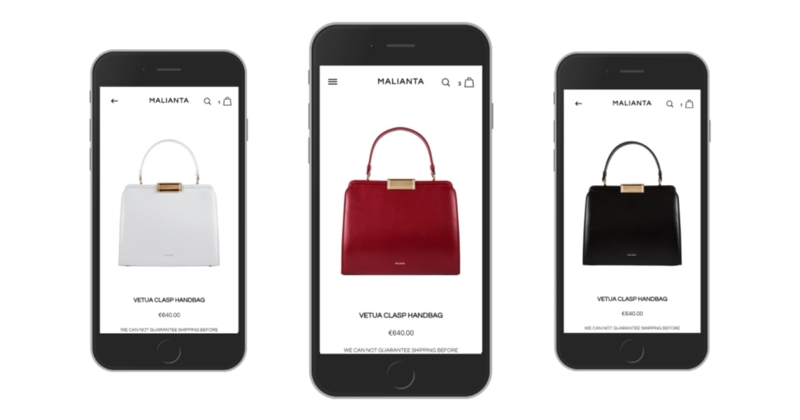To outrun old, well-established fashion houses, rising fashion stars focus on online presence. Social media, like Instagram, is a powerful channel for reaching fashion enthusiasts worldwide, and a way to maintain flexibility in testing new designs and markets — but how to turn such traffic into sales? Technology is the key.
Eager to learn about solutions that lie behind successful online stores, I spoke with Gabriele Conti Taguali, founder and director of Malianta, an Italian startup specialized in hand-made leather bags and small leather goods. For the last year, Malianta has been testing the online market and finally decided to launch the new store using the mobile-first approach.

Gabriele, you entered the leather handbags market over a year ago with testing it.
Yes, we started our activity with re-selling white labeled products, but that was not our final goal. It was necessary for us in order to test the online market for this kind of product. From the beginning, we knew we wanted to launch our own designs and now we are proud to say that all women’s bags and accessories available in Malianta’s store are designed and produced here, in Milan, by our talented young designers and craftsmen.
You decided to build your business with a modern approach to compete with multinational brands. What benefits of that decision do you observe today?
Our brand is focused on being online. We define ourselves as an “Online Fashion Brand” instead of just a “Fashion Brand”. We want Malianta to become a worldwide brand, and we believe that the only way to do it today, with modest financial resources, is online. And in the last year, we have observed something really interesting. After just a few months on the market, our customers began asking us where our shops are, where our showrooms are. It came out that most of our customers believe that we are a multinational company with thousands of employees, while we are just a start-up.
I think this is the more fascinating thing about having an online store: you can show a picture of yourself that’s even better than it really is. I do not think this is “a way to trick” the customer but instead, it’s something that really pays for your ability to communicate and to express yourself.
Anyway, we do not have a showroom or a brick-and-mortar shop (yet) and we’re not really interested in selling some bags with our own brand in Milan. There are many, many shops doing this here…
Creating an online-oriented fashion brand requires an eCommerce platform that supports your every business decision. I wonder, what was your choice?
We started our online business with the Shopify platform and it worked for a while. It was easy to use and to maintain. Shopify has been our eCommerce platform for a couple of months but every new add-on made it heavy and unstable. What’s more, it became expensive. We could accept the monthly fee but we didn’t like to pay for every sale we were making.
So, in January 2018, we set up a Magento 2 shop and we were really happy about that. Magento provides so many functionalities just for free. Sadly, very soon we understood that the front-end performance was going to kill us over the long term. The website was slow, and all our pay-per-click campaigns had a high bounce rate due to loading speed of the landing pages.
We started a load of work on performance of our Magento 2 frontend. We “cut” all the useless functionalities and there we understood that “less is more”. The performance tests were better but we were not yet satisfied with them.

With the poor performance, you would keep losing customers and revenue. What was your idea to fix remaining performance issues with Magento 2?
When we started working on Magento 2 frontend performance, we hired this awesome programmer from India. Almost at the finish, we had a long discussion about the limits of Magento 2 and we understood that what we wanted to fix, in terms of performance, could not be fixed in that way. We needed to completely change the solution and he showed me one Github project — Alokai. The thing was still in its early stages: no production-ready version, no live stores with that implementation. But I checked out the demo website and was impressed by the performances and design of its frontend. Those were exactly the performance results I was looking for and I thought the Malianta website deserved them.
I forgot about Alokai for a while, but after some weeks I could not really think about anything else. “Alokai” was echoing in my mind and I really wanted to test it. At the end of the summer, I wrote to the VS team and spoke with Piotr Karwatka. He really gave me the energy and support to start this project and invited me to the Slack community. That was the moment when I thought “Hey, I’m not alone.”
So, you entered a project with a very fresh solution. Some might say it’s quite risky. What was your feeling?
Working with Alokai was like being one of the first men on Mars. Every day was exciting because we could really feel we were implementing something powerful and brand new.
For us, it was like pioneering and it was amazing to test the platform with our products, with our logo on it. We could feel we were making something really good for our customers, it was more than giving them a discount on a product.
We were starting giving their time back. No more infinite loading pages.
Who is “us”? Tell us more about your team and experience.
Well, I really wish I could say that “4 people with a senior level” worked on the VS project but it’s not. It was just me, and it took approximately one month (not every day, not all day).
Talking about my experience, I’m not a programmer, I’m a mechanical engineer with modest programming skills. Reading most of the languages isn’t a problem but I can really write only html, python and C++. I asked for a lot of help from the VS community, but I could find most of the answers online on the Github project page and in the documentation. In the very end, I have to say that that the team behind the Malianta project is huge, more than 200 people from all around the world and with different experience.
That sounds like a pretty solid backup team! What were the problems you solved together?
The main problem with implementation was setting up the server in order to give Alokai all the necessary resources to work. We started from a raw droplet on digitalocean (supported by Ubuntu and ngnix) and that consumed the majority of the project’s time. I have to admit, I created and deleted more than 10 droplets before I could find the best solution for my website.
I could find many of the answers on the Github project page and in the documentation, but I also asked for a lot of help from the VS community. Without them Malianta could not really go with Alokai, so “thank you” to them, and a particular thanks to @pkarw, @allozaur, @jan, @nuovecode from the Bitbull team.
Malianta’s online store was launched in November 2018. Is it in its final form?
Well, it is for now. But I’m working on it every day in order to enhance the customer experience and to add suggestions coming from friends and observers.
Right now we still have the checkout process on the Magento 2 frontend and our future development will focus on the checkout side. We would like to let our customers checkout without leaving the Alokai experience. So we need to make some implementation of the payment methods we are using.

You mentioned the importance of “less is more”. How did you approach it in Malianta?
We didn’t want to have any unique features on our store because we think that our customers just want the process to be easy and clear. We did some huge personalization on the UI in particular for the product page.
Less information, more product experience.
And last, but not least: how do you prepare for peak seasons, just like Black Fridays?
We launched our new website with VS on Black Friday in order to stress it. We can just say that customers were enthusiastic about the performances and the new frontend.
And I cannot say more, but it reflected in sales :).

















